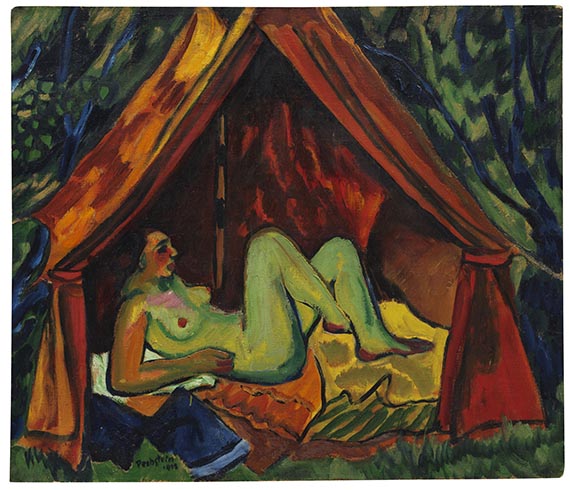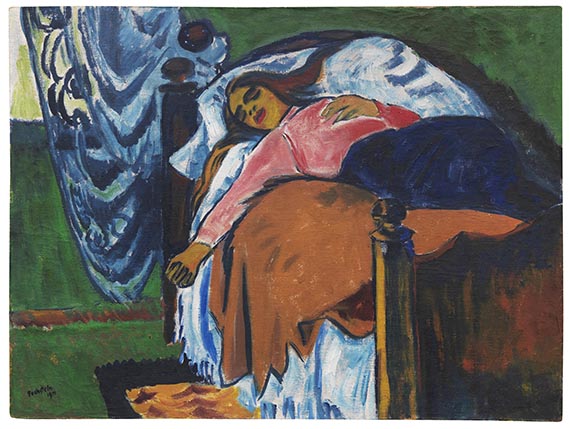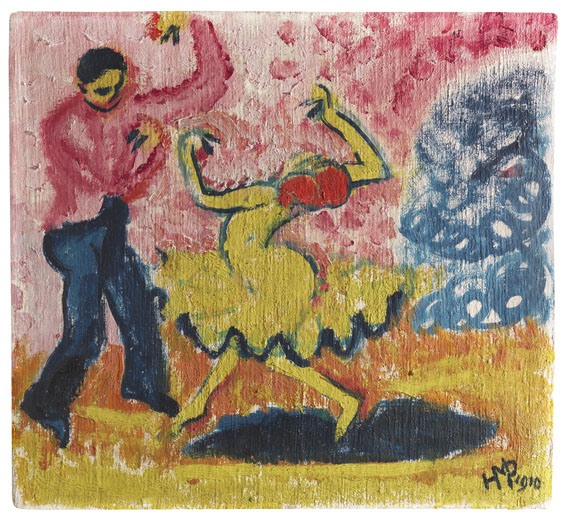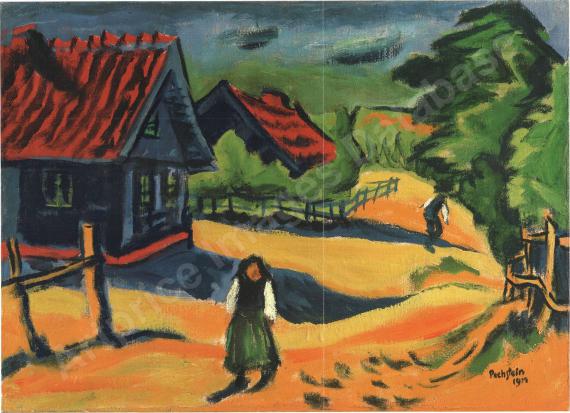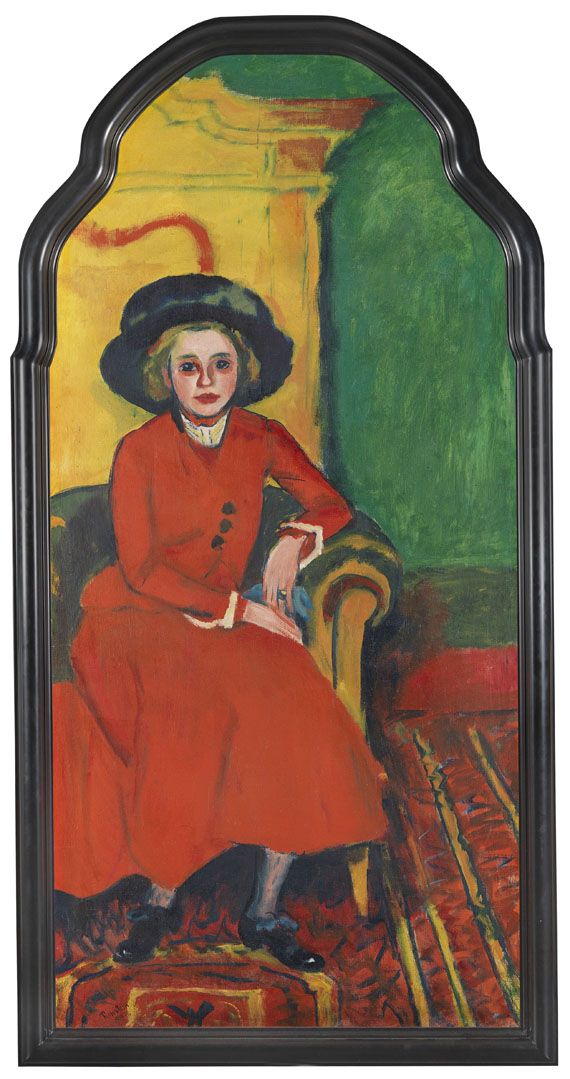Sale: 550 / Evening Sale, June 07. 2024 in Munich  Lot 124000042
Lot 124000042
 Lot 124000042
Lot 124000042
124000042
Hermann Max Pechstein
Rotes Zelt mit weiblichem Akt: Danae, 1911.
Oil on canvas
Estimate:
€ 300,000 - 400,000
$ 321,000 - 428,000
Information on buyer's premium, taxation and resale right compensation will be available four weeks before the auction.
Rotes Zelt mit weiblichem Akt: Danae. 1911.
Oil on canvas.
Signed and dated in lower margin left of the center. Reverse of the stretcher with several gallery and exhibition labels, labels of the frame maker Eduard Schmidt, Leipzig, label of Galerie Remmler, Leipzig, numbered "1008" and the label of the collection of Dr. Karl Lilienfeld and a label of Van Diemen-Lilienfeld Galleries, New York; with the number "[?]902 E" and with a label numbered "6084 / 3". 71 x 80.5 cm (27.9 x 31.6 in).
[KT].
• Painted during a stay with Lotte in Nida, where they both spent the nights in red tent in the dunes.
• One of three paintings from this eventful and productive summer, showing the red tent of the newly married couple in early 1911.
• In 1952, the Bavarian State Painting Collections acquired "Akt im Zelt" (1911) from the artist.
• In terms of composition, this is the most successful version of the nude in a tent.
• For 15 years on loan in three of the most important US museums (Busch-Reisinger Museum, Cambridge/Mass., San Francisco Museum of Art, Dallas Museum of Fine Arts).
• Important provenance: originally in the collection of the art historian and gallery owner Dr. Karl Lilienfeld (1885-1966).
PROVENANCE:
Dr. Karl Lilienfeld Collection(1885-1966), Leipzig/ Berlin/ New York (1917-1966, with the label).
Margarete Lilienfeld, New York (1966-1983).
Art dealer Wolfgang Werner, Bremen (1983).
Charles Tabachnick Collection, Toronto (1983-1988; Sotheby’s, June 28, 1988).
Mrs. Frederick Haviland Burgevin, New York.
Private collection Switzerland (1988-ca. 1990).
Galerie Thomas, Munich (1990).
Private collection Italy (acquired in 1993, ever since family-owned).
EXHIBITION:
Max Pechstein, Kunstverein, Leipzig, März 1917, no. 7 (Rotes Zelt mit weiblichem Akt, supplemented 'Danae' by the artist ).
Exhibition of paintings by Max Pechstein, The College Art Association, Lilienfeld Galleries, New York, December 12 - December 31, 1932, no. 5 (Nude, supplemented 'Rotes Zelt' by Lilienfeld, with the label)
Busch-Reisinger Museum, Harvard University, Cambridge/Mass., 1935-1937 (on loan from Dr. Karl Lilienfeld).
San Francisco Museum of Art, San Francisco, May 24, 1937 - mid 1938 (on loan from Dr. Karl Lilienfeld, with the label).
Dallas Museum of Fine Arts, Dallas, 1947-1950 (on loan from Dr. Karl Lilienfeld).
Figures du Moderne. L'expressionisme en Allemagne 1905-1914, Dresden, Munich, Berlin, Musée national d'Art moderne, Paris, November 18, 1992 - March 14, 1993, p. 386, cat. no. 110 (illu. on p. 142, with the label).
Gli espressionisti 1905-1920, Complesso del Vittoriano, Rome, October 4., 2002 - February 2, 2003 (illu. on p. 94, with the label).
LITERATURE:
Aya Soika, Max Pechstein. Das Werkverzeichnis der Ölgemälde, vol. 1: 1905-1918, Munich 2011, p. 357, no. 1911/67 (illu.)
---
Sotheby's, London, auction 28 on June 1988, lot 42.
BK Munich, 1997, illu. in black and white on p. 263.
Gerhard Leistner, Max Pechstein, Blauer Tag 1911, Regensburg 2003 (illu. on p. 39).
"I had many happy hours of work that sent a shiver down my spine. As before, unless we stayed outside in the tent, we walked on bare feet over the sand of the dunes through the cool, fresh grass of the forest, either to the lagoon or to the beach on the Baltic Sea. We stayed outside from sunrise to sunset and only returned when it got dark.“
Quoted from: Leopold Reidemeister (ed.), Max Pechstein, Erinnerungen, Wiesbaden 1960, pp. 50-51
Oil on canvas.
Signed and dated in lower margin left of the center. Reverse of the stretcher with several gallery and exhibition labels, labels of the frame maker Eduard Schmidt, Leipzig, label of Galerie Remmler, Leipzig, numbered "1008" and the label of the collection of Dr. Karl Lilienfeld and a label of Van Diemen-Lilienfeld Galleries, New York; with the number "[?]902 E" and with a label numbered "6084 / 3". 71 x 80.5 cm (27.9 x 31.6 in).
[KT].
• Painted during a stay with Lotte in Nida, where they both spent the nights in red tent in the dunes.
• One of three paintings from this eventful and productive summer, showing the red tent of the newly married couple in early 1911.
• In 1952, the Bavarian State Painting Collections acquired "Akt im Zelt" (1911) from the artist.
• In terms of composition, this is the most successful version of the nude in a tent.
• For 15 years on loan in three of the most important US museums (Busch-Reisinger Museum, Cambridge/Mass., San Francisco Museum of Art, Dallas Museum of Fine Arts).
• Important provenance: originally in the collection of the art historian and gallery owner Dr. Karl Lilienfeld (1885-1966).
PROVENANCE:
Dr. Karl Lilienfeld Collection(1885-1966), Leipzig/ Berlin/ New York (1917-1966, with the label).
Margarete Lilienfeld, New York (1966-1983).
Art dealer Wolfgang Werner, Bremen (1983).
Charles Tabachnick Collection, Toronto (1983-1988; Sotheby’s, June 28, 1988).
Mrs. Frederick Haviland Burgevin, New York.
Private collection Switzerland (1988-ca. 1990).
Galerie Thomas, Munich (1990).
Private collection Italy (acquired in 1993, ever since family-owned).
EXHIBITION:
Max Pechstein, Kunstverein, Leipzig, März 1917, no. 7 (Rotes Zelt mit weiblichem Akt, supplemented 'Danae' by the artist ).
Exhibition of paintings by Max Pechstein, The College Art Association, Lilienfeld Galleries, New York, December 12 - December 31, 1932, no. 5 (Nude, supplemented 'Rotes Zelt' by Lilienfeld, with the label)
Busch-Reisinger Museum, Harvard University, Cambridge/Mass., 1935-1937 (on loan from Dr. Karl Lilienfeld).
San Francisco Museum of Art, San Francisco, May 24, 1937 - mid 1938 (on loan from Dr. Karl Lilienfeld, with the label).
Dallas Museum of Fine Arts, Dallas, 1947-1950 (on loan from Dr. Karl Lilienfeld).
Figures du Moderne. L'expressionisme en Allemagne 1905-1914, Dresden, Munich, Berlin, Musée national d'Art moderne, Paris, November 18, 1992 - March 14, 1993, p. 386, cat. no. 110 (illu. on p. 142, with the label).
Gli espressionisti 1905-1920, Complesso del Vittoriano, Rome, October 4., 2002 - February 2, 2003 (illu. on p. 94, with the label).
LITERATURE:
Aya Soika, Max Pechstein. Das Werkverzeichnis der Ölgemälde, vol. 1: 1905-1918, Munich 2011, p. 357, no. 1911/67 (illu.)
---
Sotheby's, London, auction 28 on June 1988, lot 42.
BK Munich, 1997, illu. in black and white on p. 263.
Gerhard Leistner, Max Pechstein, Blauer Tag 1911, Regensburg 2003 (illu. on p. 39).
"I had many happy hours of work that sent a shiver down my spine. As before, unless we stayed outside in the tent, we walked on bare feet over the sand of the dunes through the cool, fresh grass of the forest, either to the lagoon or to the beach on the Baltic Sea. We stayed outside from sunrise to sunset and only returned when it got dark.“
Quoted from: Leopold Reidemeister (ed.), Max Pechstein, Erinnerungen, Wiesbaden 1960, pp. 50-51
"Returning Nida as a bearded husband, the fishermen greeted me with a warm hello," noted Max Pechstein on the occasion of his second stay in the small fishing village on the Curonian Spit from mid-June to September 17, 1911 ( quoted from Max Pechstein, Erinnerungen, ed. by Leopol Reidemeister, Wiesbaden 1960, p. 59). The architect and patron Bruno Schneidereit had given him some money in advance to pay for the trip to the town far away from Berlin city life in East Prussia. Although the number of visitors had increased from Pechstein's first stay in 1909, the vast dune landscapes and sparse pine forests still offered plenty of secluded and hidden places to paint nudes. In the heyday of the Brücke period, nude plein-air painting as an expression of naturalness and liberation from social and painterly conventions had become a defining element in the group's understanding of art.
After their wedding on March 19, 1911, Pechstein was accompanied by his wife Charlotte "Lotte" Kaprolat for the first time. He had met her at the studio of the fellow sculptor Georg Kolbe, for whom she posed as a model. From then on, she sat for most of his works and became a key source of inspiration: "I was extremely lucky to constantly have a person around me who actsd completely natural and who let me absorb her movements. So I continued my quest to capture man and nature as one, more strongly and inwardly than in Moritzburg in 1910." (quoted from ibid., p. 50). From morning to evening, the couple spent their days in the dunes and by the sea, for which Pechstein had already taken precautions: "I supplemented my working materials with a small tent so that I could take shelter from bad weather in the dunes or in the forest, on the lagoon or by the Baltic Sea. Over the course of the summer, it had turned out a great idea. It saved me many arduous journeys." (quoted from ibid., pp. 48f). Sometimes the two did not even return to their accommodation in the village but spent the night in the small red tent, as Pechstein reported to his artist colleague Heckel: "I spent the night outside a few times in a tent that I had brought with me." (Letter to E. Heckel, Berlin, 21.9.1011, Altonaer Museum, quoted from Aya Soika, Max Pechstein, vol. I, Munich 2022, p. 36).
That summer he created some of his most beautiful and most powerful works, always using Lotte as an inspiration and showing her as a motif characterized by the light-heartedness of a newlywed couple in love. Pechstein gained immense artistic energy from their intimacy and immersion in nature: "There were many happy hours of work that sent shivers down my spine. As before, unless we stayed outside in the tent, we walked barefoot on the dunes, through the cool, fresh forest grass, either to the lagoon or to the beach of the Baltic Sea. We stayed outside from sunrise to sunset and only returned at dusk." (quoted from ibid., pp. 50f). For Pechstein, Lotte was the muse that perfectly realized his artistic ideas, as her appearance and temperament reminded him of the wild originality that he suspected in the Tahitian women of his great idol Paul Gauguin. During this stay, he also painted the emblematic portrait of Lotte as a South Sea Beauty (today Neue Nationalgalerie, Berlin). In February 1911, he had seen Gaugin's Tahitian paintings in an exhibition at Fritz Gurlitt's gallery in Berlin, which had already been shown parallel to a Brücke exhibition at Galerie Arnold in Dresden in September 1910.
Pechstein had become increasingly bolder in using colors and, above all, also in terms of composition - making the almost classical composition of a nude resting in a tent all the more extraordinary. The homage both to his young wife and to the Italian masters, whom he may have encountered on a trip to Rome in February, gets an erotic connotation from the mythological title. Titian's 'Danae', one of the most famous versions of the subject, defines the iconography of the red, tent-like curtain and the coloristic mood of red and yellow-gold tones. The opening curtain becomes an erotic topos, revealing the recumbent body that is ready to conceive. It is possible that Pechstein was all too aware of this erotic component and that it was probably also present in his memory of the summer, which is why the work was subsequently disguised as a mythological scene. Pechstein thus succeeds in building a fascinating bridge between art-historical tradition, avant-garde modernism and pre-civilizational primitivism, in which the eclectic power of a synthesizing modernism is embodied in a most exemplary way. [KT]
After their wedding on March 19, 1911, Pechstein was accompanied by his wife Charlotte "Lotte" Kaprolat for the first time. He had met her at the studio of the fellow sculptor Georg Kolbe, for whom she posed as a model. From then on, she sat for most of his works and became a key source of inspiration: "I was extremely lucky to constantly have a person around me who actsd completely natural and who let me absorb her movements. So I continued my quest to capture man and nature as one, more strongly and inwardly than in Moritzburg in 1910." (quoted from ibid., p. 50). From morning to evening, the couple spent their days in the dunes and by the sea, for which Pechstein had already taken precautions: "I supplemented my working materials with a small tent so that I could take shelter from bad weather in the dunes or in the forest, on the lagoon or by the Baltic Sea. Over the course of the summer, it had turned out a great idea. It saved me many arduous journeys." (quoted from ibid., pp. 48f). Sometimes the two did not even return to their accommodation in the village but spent the night in the small red tent, as Pechstein reported to his artist colleague Heckel: "I spent the night outside a few times in a tent that I had brought with me." (Letter to E. Heckel, Berlin, 21.9.1011, Altonaer Museum, quoted from Aya Soika, Max Pechstein, vol. I, Munich 2022, p. 36).
That summer he created some of his most beautiful and most powerful works, always using Lotte as an inspiration and showing her as a motif characterized by the light-heartedness of a newlywed couple in love. Pechstein gained immense artistic energy from their intimacy and immersion in nature: "There were many happy hours of work that sent shivers down my spine. As before, unless we stayed outside in the tent, we walked barefoot on the dunes, through the cool, fresh forest grass, either to the lagoon or to the beach of the Baltic Sea. We stayed outside from sunrise to sunset and only returned at dusk." (quoted from ibid., pp. 50f). For Pechstein, Lotte was the muse that perfectly realized his artistic ideas, as her appearance and temperament reminded him of the wild originality that he suspected in the Tahitian women of his great idol Paul Gauguin. During this stay, he also painted the emblematic portrait of Lotte as a South Sea Beauty (today Neue Nationalgalerie, Berlin). In February 1911, he had seen Gaugin's Tahitian paintings in an exhibition at Fritz Gurlitt's gallery in Berlin, which had already been shown parallel to a Brücke exhibition at Galerie Arnold in Dresden in September 1910.
Pechstein had become increasingly bolder in using colors and, above all, also in terms of composition - making the almost classical composition of a nude resting in a tent all the more extraordinary. The homage both to his young wife and to the Italian masters, whom he may have encountered on a trip to Rome in February, gets an erotic connotation from the mythological title. Titian's 'Danae', one of the most famous versions of the subject, defines the iconography of the red, tent-like curtain and the coloristic mood of red and yellow-gold tones. The opening curtain becomes an erotic topos, revealing the recumbent body that is ready to conceive. It is possible that Pechstein was all too aware of this erotic component and that it was probably also present in his memory of the summer, which is why the work was subsequently disguised as a mythological scene. Pechstein thus succeeds in building a fascinating bridge between art-historical tradition, avant-garde modernism and pre-civilizational primitivism, in which the eclectic power of a synthesizing modernism is embodied in a most exemplary way. [KT]
124000042
Hermann Max Pechstein
Rotes Zelt mit weiblichem Akt: Danae, 1911.
Oil on canvas
Estimate:
€ 300,000 - 400,000
$ 321,000 - 428,000
Information on buyer's premium, taxation and resale right compensation will be available four weeks before the auction.




